How to Measure a Bike Frame Size
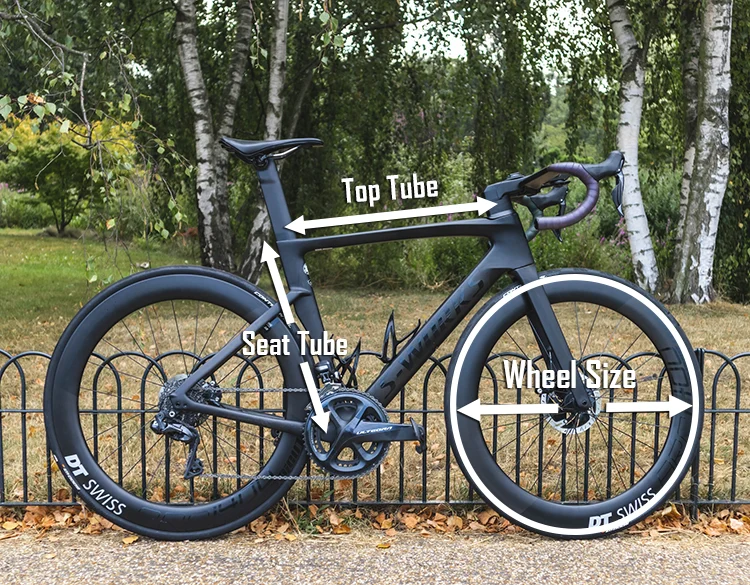
Understanding how to measure a bike frame size is crucial for both casual cyclists and avid enthusiasts to fully enjoy cycling.
By ensuring you have the correct bike frame size, you’ll significantly improve your cycling experience, from performance to comfort and ensure that your bike fits you.
The calculator on this page helps you do just that choosing the type of your bike and entering the length of the seat tube.
How to Measure a Bike Frame?
To use the calculator below and measure the size of your bike’s frame, you’ll need to know the length of its seat tube, from the center of the bottom bracket to the top of the seat tube (not the seatpost).
Follow the steps below if you don’t know how to do it:
- Identify the Bottom Bracket: This is the circular axle that holds the pedal cranks together. It’s the lowest part of the bike frame.
- Locate the Top of the Seat Tube: This is where the seat clamp holds the seat post and where the seat post enters the frame.
- Measure the Distance: Using a tape measure, measure the length from the center of the bottom bracket to the top of the seat tube. Do this is centimeters (cm) for road bike frame sizes and in inches for hybrids, mountain and BMX bikes.
Start by choosing the correct type of bike below.
Which bike would you like to measure?
Road Bike
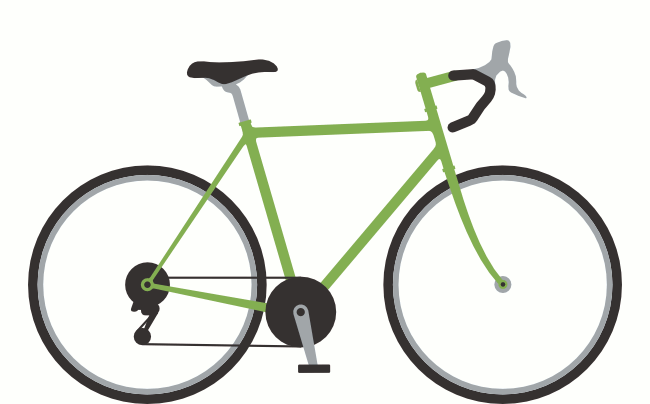
Road bikes have sleek frames and thinner tires for riding on hard smooth surfaces.
Mountain Bike
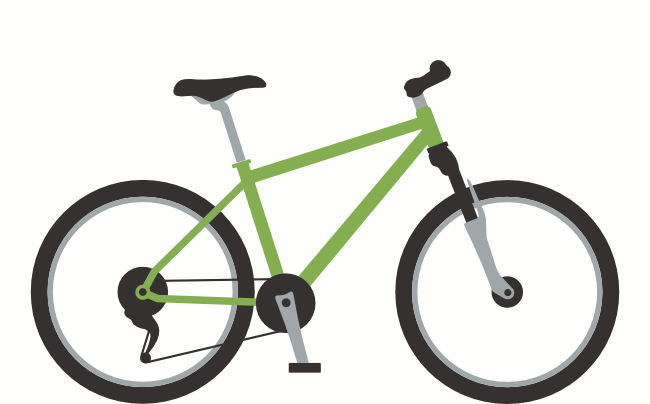
Mountain bikes have sturdy frames and thick knobby tires for riding on rough, bumpy surfaces.
BMX Bike
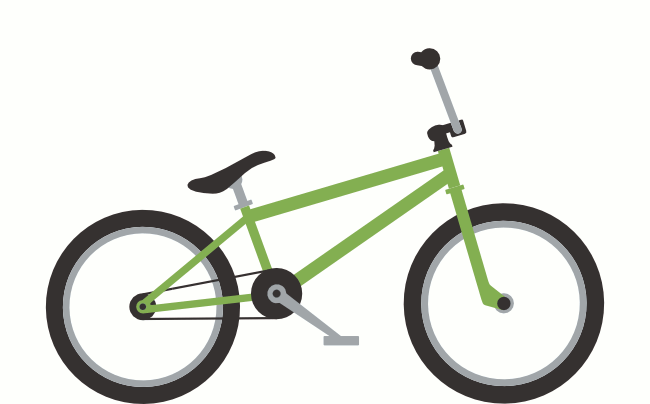
BMX bikes have sturdy compact frames and smaller tires for riding and racing on dirt or asphalt surfaces.
Kids Bike
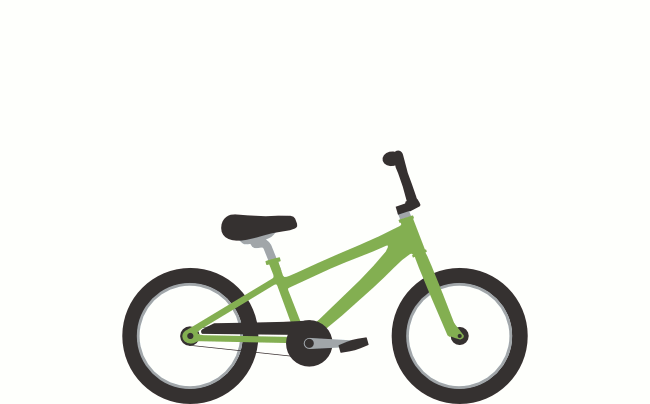
Kids bikes have small frames and tires for riding on hard flat surfaces.
Crucial Measurements to Compare Similar Bikes
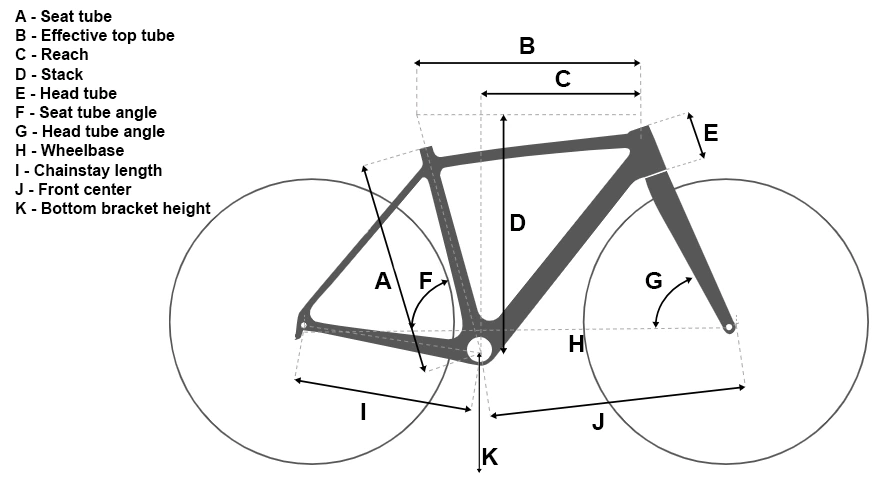
Bike geometry is a complex relationship of angles and lengths that determines how a bike should feel and perform while riding.
While all bikes are unique in terms of ratios between these numbers, they are also similar and can be easily compared if you know what and how to measure. This is important if you're going to purchase a new bike and want to make sure it's similar to your old one.
In addition to measuring the seat tube length (explained above), other crucial measurements you need to consider when comparing similar bikes include:
- Effective (virtual) top tube length
- Reach and stack
- Wheelbase
- Chainstay length
- Front center
- Seat tube and head tube angles
- Bottom bracket height
- Bottom bracket drop
Let's take a closer look at each of these geometry terms, explain how to measure them, and understand why they are important.
NB: All measurements should be performed in centimeters. If, for some reason, you need imperial units, you can just divide the centimeters by 2.54.
Effective (virtual) top tube length
The top tube measurement is important because it lets you know how long a bike is, crucial for determining its reach.
Early on, most bicycles had horizontal top tubes, so comparing them was easy. However, many modern bikes have sloping top tubes, which could skew our measurements. That's why we need to measure the effective top tube length, which is the horizontal distance between the center line of the head tube and the center line of the seat tube.
How to measure: Take a spirit level or a long straight board and a smartphone with a clinometer app (to ensure the board is horizontal) and measure horizontally, in a straight line, from the center of the head tube to the center of the seat tube.
Reach and stack
The reach and stack values are the best way to compare between different frames, as the top tube and seat tube can be a hit-and-miss from one manufacturer to another.
The reach is the horizontal distance between the bottom bracket and the top of the head tube, telling you how stretched you will be on the bike and how your hands will rest on the handlebars.
The stack is the vertical distance between the bottom bracket and the top of the head tube, telling you how upright you will be sitting on the bike.
How to measure reach: For this step, you will need to keep your bike upright and perfectly still. Then, take a plumb line (you can improvise with a string and a nut) and hang it from the top of the head tube length to the ground. Mark the position on the ground. Then hang the plumb line from the center of the bottom bracket and mark the position on the ground. Measure the distance between the two points, which will give you your reach value.
How to measure stack: To measure stack, you should again hang the plumb line from the top of the head tube to the ground and measure the distance between the two. Next, hang the plumb line from the bottom bracket to the ground and measure this distance as well. Finally, subtract the bottom bracket height from the head tube height and the resulting number will be your stack value.
Wheelbase
The wheelbase refers to the distance between the bike's front and rear wheel axles. It determines the bike's length and its riding feel and behavior. A longer wheelbase equals to more stability, while a shorter wheelbase equals to a more twitchy and nimble ride.
How to measure: Hang a plumb line from each of the wheel's axles and mark the positions on the ground. Measure the distance between the two points to determine the wheelbase.
Chainstay length
Chainstay length is the 'rear part' of the wheelbase, corresponding to the distance between the bottom bracket and the rear axle. It contributes greatly to the ride attributes, as a frame with shorter chainstays will typically feel more lively than one longer chainstays.
How to measure: Measure in a straight line (not horizontal) between the center of the bottom bracket to the center of the rear wheel axle with a ruler or a measuring tape.
Front center
The front center is the 'front part' of the wheelbase, corresponding to the distance between the bottom bracket and the front axle. It affects the handling of the bike, as well as toe overlap, which is why it's important to measure it, even though it's not often shown by bike manufacturers.
How to measure: Measure the distance between the bottom bracket and the front wheel's axle in a straight line (not horizontal).
Seat tube and head tube angles
The seat tube and head tube angles affect how a bike handles, and are especially important on mountain bikes. A more upright angle translates to a more nimble ride, whereas a slacker angle translates to a more stable ride. The choice boils down to personal preference.
How to measure: The easiest way to measure is with a clinometer app on your smartphone. To measure the head tube angle, simply align your phone with the centerline of the head tube (disregard the fork angle). Similarly, to measure the seat tube angle, align your phone with the seat tube, unless there's a bend in the seat tube. If that's the case, take a straight board, align it with the center of the bottom bracket and the top center of the seat tube, and line your phone with it.
Bottom bracket height
The bottom bracket height is the distance between the center of the bottom bracket to the ground. This measurement is especially important on mountain bikes and gravel bikes as it tells you how much clearance you have to avoid obstacles.
How to measure: Measure in a straight (vertical) line from the center of the bottom bracket to the ground. Use a plumb line for maximum accuracy. Keep in mind that the bottom bracket height is affected by wheel size, tire size, and tire pressure.
Bottom bracket drop
Finally, the bottom bracket drop is the difference between the height of the wheel axles and the height of the bottom bracket. A smaller bottom bracket drop translates to better cornering and faster response times, as it lowers the rider’s center of gravity, making them more stable.
How to measure: Find the height of the rear or front axle and the height of the bottom bracket, then subtract one from the other.
Frequently Asked Questions

1. How to measure the size of a bike frame?
To measure the size of a bike frame, you need to measure the length of the seat tube, from the center of the bottom bracket to the place where the seat post enters the seat tube. Another important measurement is the top tube length, which is measured from the middle of the seat tube to the middle of the head tube. This is how to measure the size of a bike frame.
2. What does a 26-inch bike mean?
A 26-inch bike refers to the diameter of its wheels. However, using wheel diameter as the only metric when choosing a bike size is misleading. The frame size, which relates to rider comfort and ergonomics, is a more important determinant for selecting the appropriate bike size for an individual.
3. What size is a 17-inch bike frame?
A 17-inch bike frame is a frame with a seat tube that's 17" long. We've explained what a seat tube is and what its importance is when we described how to measure a frame size on a bike. A 17-inch bike frame size is sometimes also classified as Medium (M), though this type of classification is not as precise.
4. What is the correct bike frame size for height?
The correct bike frame size varies based on the rider's height, inseam length, and the type of riding they want to do. To determine the right frame size for your height, you should refer to the manufacturer's bike size chart or use an online calculator that can recommend the right size based on your measurements.
More on eBicycles:
Measure Mountain Bike Frames - (Rigid | FS | Hardtail)
Measure Road Bike Frames - (Classic | Compact | Mixte)
BMX Bikes - (Freestyle | Racing)
Kids Bikes - (Balance | 12 | 16 | 20 | 24)